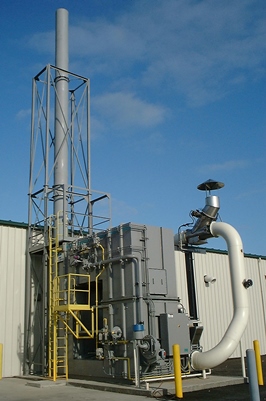
Treating Chlorinated Compounds from Groundwater Remediation
The complete vapor treatment system consists of several design features that ensure safe and effective operation in the expected challenging process environment.
A Fortune 50 company implemented a remediation project to collect and treat polluted groundwater from a site in Central New York, preventing the migration of impacted groundwater into local waterways. The responsible party hired an engineering and construction firm to design and build an effective, efficient groundwater treatment system. Polluted ground water was pumped and collected into equalization storage tanks and then treated by air strippers before being sent to a final treatment facility located along the shoreline of a nearby body of water. The off-gases from the tanks as well as the air stripper exhaust were laden with Volatile Organic Compounds (VOCs), such as benzene, chlorobenzene, and dichlorobenzene, and required further treatment before being released to the atmosphere.
 The design-builder required a treatment system capable of destroying at least 99 percent of the VOCs and safely remove any resultant inorganic acids formed during the oxidization process. As this was a long-term project, the VOC control system needed to be highly reliable and provide low operational costs.
The design-builder required a treatment system capable of destroying at least 99 percent of the VOCs and safely remove any resultant inorganic acids formed during the oxidization process. As this was a long-term project, the VOC control system needed to be highly reliable and provide low operational costs.
After a thorough technical and vendor evaluation process, the design-builder selected Anguil Environmental Systems to provide the VOC treatment solution. Anguil's extensive engineering support, industry-leading reliability, and history of solving difficult halogenated destruction problems around the world made them the obvious choice. Anguil engineers recommended a Model 50 Regenerative Thermal Oxidizer (RTO) with an Acid Gas Scrubber. The system processes up to 5,000 SCFM of VOC-laden air and provides 99 percent VOC destruction efficiency and 99 percent by weight hydrochloric acid removal efficiency.
Anguil's engineering resources and experience processing halogenated contaminants were crucial to this project. Inside the two-chamber RTO, the polluted air is heated as it passes through stoneware beds located in an energy recovery chamber. The preheated process air moves from the recovery chamber toward the combustion chamber, where the VOCs are oxidized, releasing energy into the second energy recovery chamber. A flow-diverter valve switches the airflow direction, fully utilizing both energy recovery beds, achieving 95 percent heat recovery, and thereby reducing any auxiliary fuel requirement. With such an efficient system, the Anguil RTO provides the customer with significantly lower operating costs than other treatment technologies.
Because the oxidation of chlorinated compounds produces hydrochloric acid, RTO exhaust laden with acid gas is transferred into a countercurrent scrubber module that removes and neutralizes inorganic acids. In the scrubber, recirculation pumps inject large amounts of water into the adiabatic quench through separate spray headers and cools the RTO exhaust. Condensed water is recaptured by the recycle sump. The air leaves the quench and enters the bottom of a countercurrent packed tower scrubber, where the remaining acid gases are absorbed by an injected solution as the air proceeds up through the column. The acid-free air then passes through a mist eliminator to remove entrained water before exiting the scrubber column. Sodium hydroxide solution is added to the re-circulating water in the packed tower scrubber to neutralize the adsorbed acids and form a salt solution. The rate of sodium hydroxide addition is controlled by a pH analyzer and the salt water blow-down by a conductivity analyzer.
The complete vapor treatment system consists of several design features that ensure safe and effective operation in the expected challenging process environment. First, an induced draft design, where the system fan is located downstream of the scrubber, was chosen to pull halogenated VOC laden air through the system. An induced draft arrangement, which creates a negative air pressure inside the process equipment, is preferred for halogenated applications because the corrosive hydrochloric acid produced during oxidization inside the RTO can leak through instrumentation (thermocouple) penetrations from the positive pressure created by a forced draft arrangement. Condensation of corrosive gases at this interface leads to corrosion of the outer shell and potentially failure of the equipment.
Secondly, special consideration was also paid to the materials of construction to ensure performance in a corrosive environment. The RTO outer reactor shell was constructed of carbon steel and covered with a special corrosion-resistant coating resistant to hydrochloric acid (vapors or condensed acid) that could potentially reach the outer skin. Diverter valves on the RTO were fabricated out of a high nickel alloy, while transitions from the RTO outlet plenum and the acid gas scrubber quench were constructed of Hastelloy. The scrubber tower, sump, and stack were all fabricated out of FRP (Fiberglass Reinforced Plastic). These material selections have been field proven in Anguil's many halogenated installations.
Finally, equipment location at the facility was carefully selected to reduce installation costs and minimize equipment downtime. The scrubber was installed inside the treatment building, eliminating the concern of freezing during cold months and costs associated with winterization. The oxidizer was placed outdoors adjacent to the treatment building and near the scrubber system to eliminate extensive ductwork runs.
For more information, contact Anguil Environmental Systems at 8855 N. 55th St., Milwaukee, WI 53223, 414-365-6400, www.anguil.com.